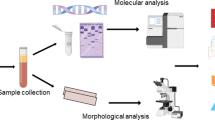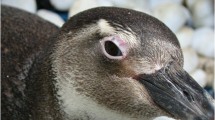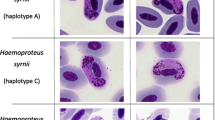Abstract
Parasites of the genus Haemoproteus are vector-borne avian haemosporidia commonly found in bird species of the world. Haemoproteus infections are typically considered relatively benign in birds. However, some Haemoproteus species cause severe disease and mortality, especially for captive birds removed from their original habitat. In September 2018, a captive 15-year-old snowy owl (Bubo scandiacus), kept in a zoological garden of Japan, died subacutely after presenting leg dysfunction. This case showed significantly low PCV and elevated AST, ALT, CK, and LDH values. Many megalomeronts with prominent morphological characteristics of Haemoproteus were observed in the left leg muscles. Those megalomeronts exhibited multilocular structures and were internally filled with merozoites. A new lineage of Haemoproteus was detected by subsequent PCR for the cytochrome b (cytb) gene of avian haemosporidia from DNA extracted from several organ tissues. The detected lineage was classified in the subgenus Parahaemoproteus and was similar to those from the wild birds inhabiting the region including the study area, suggesting that this snowy owl likely acquired its infection from wild birds. This is the first report of a fatal case of a captive bird with a locally transmitted Haemoproteus infection in Japan. We considered the pathogenicity of this infection in conjunction with the clinical course and hematology results. We surmise that snowy owls may be particularly susceptible to infection with Haemoproteus parasites, and warming northern temperatures may exacerbate the overall health of these and other high latitude birds. Further research into the prevalence of Haemoproteus in wild birds near zoological gardens and potential biting midge vectors is necessary for the ex situ conservation of introduced birds.


Similar content being viewed by others
References
Altizer S, Ostfeld RS, Johnson PTJ, Kutz S, Harvell CD (2013) Climate change and infectious diseases: from evidence to a predictive framework. Science 341:514–519. https://doi.org/10.1126/science.1239401
Ammersbach M, Beaufrère H, Gionet Rollick A, Tully T (2015a) Laboratory blood analysis in strigiformes-part I: hematologic reference intervals and agreement between manual blood cell counting techniques. Vet Clin Pathol 44:94–108. https://doi.org/10.1111/vcp.12229
Ammersbach M, Beaufrère H, Gionet Rollick A, Tully T (2015b) Laboratory blood analysis in strigiformes-part II: plasma biochemistry reference intervals and agreement between the Abaxis Vetscan V2 and the Roche Cobas c501. Vet Clin Pathol 44:128–140. https://doi.org/10.1111/vcp.12230
Apanius V, Kirkpatrick CE (1988) Preliminary report of Haemoproteus tinnunculi infection in a breeding population of American kestrels (Falco sparverius). J Wildl Dis 24:150–153. https://doi.org/10.7589/0090-3558-24.1.150
Atkinson C, Greiner E, Forrester D (1986) Pre-erythrocytic development and associated host reesponses to Haemoproteus meleagridis (Haemosporina: Haemoproteidae) in experimentally infected domestic turkeys. J Protozool 33:375–381. https://doi.org/10.1111/j.1550-7408.1986.tb05626.x
Atkinson C, Forrester D, Greiner E (1988) Pathogenicity of Haemoproteus meleagridis (Haemosporina: Haemoproteidae) in experimentally infected domestic turkeys. J Parasitol 74:228–239. https://doi.org/10.2307/3282448
Baker KC, Rettenmund CL, Sander SJ, Rivas AE, Green KC, Mangus L, Bronson E (2018) Clinical effect of hemoparasite infections in snowy owls(Bubo scandiacus). J Zoo Wildl Med 49:143–152. https://doi.org/10.1638/2017-0042R.1
Bensch S, Stjernman M, Hasselquist D, Ostman O, Hansson B, Westerdahl H, Pinheiro RT (2000) Host specificity in avian blood parasites: a study of Plasmodium and Haemoproteus mitochondrial DNA amplified from birds. Proc. R. Soc. B Biol. Sci. 267:1583–1589. https://doi.org/10.1098/rspb.2000.1181
Bensch S, Hellgren O, PÉrez-Tris J (2009) MalAvi: a public database of malaria parasites and related haemosporidians in avian hosts based on mitochondrial cytochrome b lineages. Mol Ecol Resour 9:1353–1358. https://doi.org/10.1111/j.1755-0998.2009.02692.x
BirdLife International (2017) Bubo scandiacus (errata version published in 2018). The IUCN Red List of Threatened Species 2017: e.T22689055A127837214. https://doi.org/10.2305/IUCN.UK.2017-3.RLTS.T22689055A119342767.en. Downloaded on 18 July 2020
Bishop MA, Bennett GF (1989) The haemoproteids of the avian order Strigiformes. Can J Zool 67:2676–2684. https://doi.org/10.1139/z89-378
Borji H, Moghaddas E, Razmi GH, Bami MH, Mohri M, Azad M (2011) Prevalence of pigeon haemosporidians and effect of infection on biochemical factors in Iran. J Parasit Dis 35:199–201. https://doi.org/10.1007/s12639-011-0056-1
Bukauskaitė D, Žiegytė R, Palinauskas V, Iezhova TA, Dimitrov D, Ilgunas M, Bernotienė R, Markovets MY, Valkiūnas G (2015) Biting midges (Culicoides, Diptera) transmit Haemoproteus parasites of owls: evidence from sporogony and molecular phylogeny. Parasit Vectors 8:1–11. https://doi.org/10.1186/s13071-015-0910-6
Caminade C, McIntyre KM, Jones AE (2019) Impact of recent and future climate change on vector-borne diseases. Ann N Y Acad Sci 1436:157–173. https://doi.org/10.1111/nyas.13950
Campbell TW (1994) Hematology. In: Ritchie BW, Harrison GJ, Harrison LR (eds) Avian medicine: principles and application. Wingers Publishing, Lake Worth, Florida, pp 176–198
Cardona CJ, Ihejirika A, McClellan L (2002) Haemoproteus lophortyx infection in bobwhite quail. Avian Dis 46:249–255. https://doi.org/10.1637/0005-2086(2002)046[0249:hliibq]2.0.co;2
Dimitrov D, Iezhova TA, Zehtindjiev P, Bobeva A, Ilieva M, Kirilova M, Bedev K, Sjöholm C, Valkiūnas G (2016) Molecular characterisation of three avian haemoproteids (Haemosporida, Haemoproteidae), with the description of Haemoproteus (Parahaemoproteus) palloris n. sp. Syst Parasitol 93:431–449. https://doi.org/10.1007/s11230-016-9638-8
Donovan TA, Schrenzel M, Tucker TA, Pessier AP, Stalis IH (2008) Hepatic hemorrhage, hemocoelom, and sudden death due to Haemoproteus infection in passerine birds: eleven cases. J Vet Diagnostic Investig 20:304–313. https://doi.org/10.1177/104063870802000307
Duc M, Ilgūnas M, Valkiūnas G (2020) Patterns of Haemoproteus majoris (Haemosporida, Haemoproteidae) megalomeront development. Acta Trop. 212:105706. https://doi.org/10.1016/j.actatropica.2020.105706
Earle RA, Bastianello SS, Bennett GF, Krecek RC (1993) Histopathology and morphology of the tissue stages of Haemoproteus columbae causing mortality in Columbiformes. Avian Pathol 22:67–80. https://doi.org/10.1080/03079459308418901
Evans M, Otter A (1998) Fatal combined infection with Haemoproteus noctuae and Leucocytozoon ziemanni in juvenile snowy owls (Nyctea scandiaca). Vet Rec 143:72–76. https://doi.org/10.1136/vr.143.3.72
Fukui D, Murata K, Bando G, Kosuge M, Yamaguchi M (2002) Pyrimethamine/sulfadoxine treatment against mixed avian-haematozoa infections in imported Tengmalm’s owls (Aegolius funereus). J Japan Vet Med Assoc 55:673–678 (in Japanese with English summary). https://doi.org/10.12935/jvma1951.55.673
Gonzalez G, Sorci G, Møller AP, Ninni P, Haussy C, De Lope F (1999) Immunocompetence and condition-dependent sexual advertisement in male house sparrows (Passer domesticus). J Anim Ecol 68:1225–1234. https://doi.org/10.1046/j.1365-2656.1999.00364.x
Groff TC, Lorenz TJ, Crespo R, Iezhova T, Valkiūnas G, Sehgal RNM (2019) Haemoproteosis lethality in a woodpecker, with molecular and morphological characterization of Haemoproteus velans (Haemosporida, Haemoproteidae). Int J Parasitol Parasites Wildl 10:93–100. https://doi.org/10.1016/j.ijppaw.2019.07.007
Harasym CA (2008) West Nile virus and hemoparasites in captive snowy owls (Bubo scandiacus) - Management strategies to optimize survival. Can Vet J 49:1136–1138
Harr KE (2002) Clinical chemistry of companion avian species: a review. Vet Clin Pathol 31:140–151. https://doi.org/10.1111/j.1939-165X.2002.tb00295.x
Harr KE (2006) Diagnostic value of biochemistry. In: Harrison GJ, Lightfoot TL (eds) Clinical avian medicine. Spix Publishing, Palm beach, Florida, pp 611–630
Harris RK, Gardiner CH (2017) Wednesday slide conference 2016-2017 Conference 24 case 1. Joint Pathology Center Veterinary Pathology Services https://www.askjpc.org/wsco/wsc_showcase4.php?id=UHllMEV4aXRyQkFhSVN5cnphY21oUT09
Hellgren O, Waldenström J, Bensch S (2004) A new PCR assay for simultaneous studies of Leucocytozoon, Plasmodium, and Haemoproteus from avian blood. J Parasitol 90:797–802. https://doi.org/10.1645/ge-184r1
Himmel T, Harl J, Kübber-Heiss A, Konicek C, Fernández N, Juan-Sallés C, Ilgunas M, Valkiūnas G, Weissenböck H (2019) Molecular probes for the identification of avian Haemoproteus and Leucocytozoon parasites in tissue sections by chromogenic in situ hybridization. Parasites and Vectors 12:1–10. https://doi.org/10.1186/s13071-019-3536-2
Hisada Y, Saito K, Asakawa M (2004) Epidemiological survey of Haemoproteus sp. found Blakiston’s owls (Ketupa blakistoni blakistoni) on Hokkaido Island, Japan. Japanese J Zoo Wildl Med 9:85–89 (in Japanese with English summary). https://doi.org/10.5686/jjzwm.9.85
Hochleithner M (1994) Biochemistries. In: Ritchie BW, Harrison GJ, Harrison LR (eds) Avian medicine: principles and application. Wingers Publishing, Lake Worth, pp 223–245
Holt DW, Gray K, Maples MT, Korte MA (2016) Mass growth rates, plumage development, and related behaviors of snowy owl (Bubo scandiacus) nestlings. J Raptor Res 50:131–143. https://doi.org/10.3356/rapt-50-02-131-143.1
Imura T, Suzuki Y, Ejiri H, Sato Y, Ishida K, Sumiyama D, Murata K, Yukawa M (2012) Prevalence of avian haematozoa in wild birds in a high-altitude forest in Japan. Vet Parasitol 183:244–248. https://doi.org/10.1016/j.vetpar.2011.07.027
Inumaru M, Murata K, Sato Y (2017) Prevalence of avian haemosporidia among injured wild birds in Tokyo and environs, Japan. Int J Parasitol Parasites Wildl 6:299–309. https://doi.org/10.1016/j.ijppaw.2017.09.007
Inumaru M, Aratani S, Shimizu M, Yamamoto M, Sato Y, Murata K, Valkiūnas G (2020) Penguins are competent hosts of Haemoproteus parasites: the first detection of gametocytes, with molecular characterization of Haemoproteus larae. Parasit Vectors 13:307. https://doi.org/10.1186/s13071-020-04176-1
Kakogawa M, Ono A, Inumaru M, Sato Y, Asakawa M (2019) Detection of avian haemosporidia from captive musophagid birds at a zoological garden in Japan. J Vet Med Sci 81:1892–1895. https://doi.org/10.1292/jvms.19-0483
Karadjian G, Puech M-P, Duval L, Chavatte J-M, Snounou G, Landau I (2013) Haemoproteus syrnii in Strix aluco from France: morphology, stages of sporogony in a hippoboscid fly, molecular characterization and discussion on the identification of Haemoproteus species. Parasite 20:32. https://doi.org/10.1051/parasite/2013031
Karadjian G, Martinsen E, Duval L, Chavatte J-M, Landau I (2014) Haemoproteus ilanpapernai n. sp. (Apicomplexa, Haemoproteidae) in Strix seloputo from Singapore: morphological description and reassignment of molecular data. Parasite 21:17. https://doi.org/10.1051/parasite/2014018
Kosugi K, Yamazawa T, Sato M (2013) Two records of snowy owl from Rishiri Island, northern Hokkaido. Rishiri Stud 32:17-18 (in Japanese with English summary) http://110.50.94.218/rishiri/secure/1098/3206.pdf.
Križanauskienė A, Hellgren O, Kosarev V, Sokolov L, Bensch S, Valkiūnas G (2006) Variation in host specificity between species of avian hemosporidian parasites: evidence from parasite morphology and cytochrome b gene sequences. J Parasitol 92:1319–1324. https://doi.org/10.1645/ge-873r.1
Kumar S, Stecher G, Li M, Knyaz C, Tamura K (2018) MEGA X: Molecular evolutionary genetics analysis across computing platforms. Mol Biol Evol 35:1547–1549. https://doi.org/10.1093/molbev/msy096
Lee SH, Kwak D, Kim KT (2018) The first clinical cases of Haemoproteus infection in a snowy owl (Bubo scandiacus) and a goshawk (Accipiter gentilis) at a zoo in the Republic of Korea. J Vet Med Sci 80:1255–1258. https://doi.org/10.1292/jvms.18-0072
Levin II, Valkiūnas G, Iezhova TA, O’Brien SL, Parker PG (2012) Novel Haemoproteus species (Haemosporida: Haemoproteidae) from the swallow-tailed gull (Lariidae), with remarks on the host range of Hippoboscid-transmitted avian hemoproteids. J Parasitol 98:847–854. https://doi.org/10.1645/ge-3007.1
Loiseau C, Harrigan RJ, Cornel AJ, Guers SL, Dodge M, Marzec T, Carlson JS, Seppi B, Sehgal RNM (2012) First evidence and predictions of Plasmodium transmission in Alaskan bird populations. PLoS One 7:7–11. https://doi.org/10.1371/journal.pone.0044729
Marthinsen G, Wennerberg L, Solheim R, Lifjeld JT (2009) No phylogeographic structure in the circumpolar snowy owl (Bubo scandiacus). Conserv Genet 10:923–933. https://doi.org/10.1007/s10592-008-9581-6
Metwally DM, Al-Talhi RA, Barakat IAH, ElKhadragy MF (2019) Effects of Eugenol on Haemoproteus columbae in domestic pigeons (Columba livia domestica) from Riyadh, Saudi Arabia. Biosci Rep 39:1–10. https://doi.org/10.1042/BSR20190409
Murata K (2002) Prevalence of blood parasites in Japanese wild birds. J Vet Med Sci 64:785–790. https://doi.org/10.1292/jvms.64.785
Mutlow A, Forbes N (2000) Haemoproteus in raptors: pathogenicity, treatment, and control, in: Proceedings of the 21st Annual Conference and Expo of the Association of Avian Veterinarians; 30 August-1 September 2000; Portland, Oregon. pp 157–163
Navarro C, Marzal A, De Lope F, Møller AP (2003) Dynamics of an immune response in house sparrows Passer domesticus in relation to time of day, body condition and blood parasite infection. Oikos 101:291–298. https://doi.org/10.1034/j.1600-0706.2003.11663.x
Niedringhaus KD, Fenton HMA, Cleveland CA, Anderson AN, Schwartz D, Alex CE, Rogers KH, Mete A, Yabsley MJ (2018) Case series: virulent hemosporidiosis infections in juvenile great horned owls (Bubo virginianus) from Louisiana and California, USA. Vet Parasitol Reg Stud reports 12:49–54. https://doi.org/10.1016/j.vprsr.2018.01.008
Ortiz-Catedral L, Brunton D, Stidworthy MF, Elsheikha HM, Pennycott T, Schulze C, Braun M, Wink M, Gerlach H, Pendl H, Gruber AD, Ewen J, Pérez-Tris J, Valkiūnas G, Olias P (2019) Haemoproteus minutus is highly virulent for Australasian and South American parrots. Parasit Vectors 12:1–10. https://doi.org/10.1186/s13071-018-3255-0
Paperna I, Gill H (2003) Schizogonic stages of Haemoproteus from Wenyon’s Baghdad sparrows are also found in Passer domesticus biblicus in Israel. Parasitol. Res. 91:486–490. https://doi.org/10.1007/s00436-003-0967-6
Pérez-Rodríguez A, de la Puente J, Onrubia A, Pérez-Tris J (2013) Molecular characterization of haemosporidian parasites from kites of the genus Milvus (Aves: Accipitridae). Int J Parasitol 43:381–387. https://doi.org/10.1016/j.ijpara.2012.12.007
Pornpanom P, Fernandes Chagas CR, Lertwatcharasarakul P, Kasorndorkbua C, Valkiūnas G, Salakij C (2019) Molecular prevalence and phylogenetic relationship of Haemoproteus and Plasmodium parasites of owls in Thailand: data from a rehabilitation centre. Int J Parasitol Parasites Wildl 9:248–257. https://doi.org/10.1016/j.ijppaw.2019.06.002
Ramey AM, Reed JA, Schmutz JA, Fondell TF, Meixell BW, Hupp JW, Ward DH, Terenzi J, Ely CR (2014) Prevalence, transmission, and genetic diversity of blood parasites infecting tundra-nesting geese in Alaska. Can J Zool 92:699–706. https://doi.org/10.1139/cjz-2014-0041
Samour J (2006) Management of Raptors. In: Harrison GJ, Lightfoot TL (eds) Clinical avian medicine. Spix Publishing, Palm beach, Florida, pp 915–956
Sehgal RNM (2015) Manifold habitat effects on the prevalence and diversity of avian blood parasites. Int J Parasitol Parasites Wildl 4:421–430. https://doi.org/10.1016/j.ijppaw.2015.09.001
Siriwat P, Nekaris K, Nijman V (2020) Digital media and the modern-day pet trade: a test of the ‘Harry Potter effect’ and the owl trade in Thailand. Endanger Species Res 41:7–16. https://doi.org/10.3354/esr01006
Tarello W (2005) Fatal Haemoproteus psittaci infection in an African grey parrot. Vet Rec 157:32. https://doi.org/10.1136/vr.157.1.32-b
Tarello W (2007) Clinical signs and response to primaquine in falcons with Haemoproteus tinnunculi infection. Vet Rec 161:204–206. https://doi.org/10.1136/vr.161.6.204
Tostes R, Martinele I, Vashist U, Castañon MCMN, de Faria PP, Daemon E, D’Agosto M (2015) Molecular characterization and biochemical and histopathological aspects of the parasitism of Haemoproteus spp. in southern caracaras ( Caracara plancus ). J Parasitol 101:687–693. https://doi.org/10.1645/14-713
Valkiūnas G (2005) Avian malaria parasites and other haemosporidia. CRC press, Boca Raton, Florida
Valkiūnas G, Iezhova TA (2017) Exo-erythrocytic development of avian malaria and related haemosporidian parasites. Malar J 16:1–24. https://doi.org/10.1186/s12936-017-1746-7
Valkiūnas G, Iezhova TA, Evans E, Carlson JS, Martínez-Gómez JE, Sehgal RNM (2013) Two new Haemoproteus species (Haemosporida: Haemoproteidae) from columbiform birds. J Parasitol 99:513–521. https://doi.org/10.1645/12-98.1
Valkiūnas G, Pendl H, Olias P (2017) New Haemoproteus parasite of parrots, with remarks on the virulence of haemoproteids in naive avian hosts. Acta Trop 176:256–262. https://doi.org/10.1016/j.actatropica.2017.08.004
Van Hemert C, Pearce JM, Handel CM (2014) Wildlife health in a rapidly changing north: focus on avian disease. Front Ecol Environ 12:548–555. https://doi.org/10.1890/130291
Vashist U, Falqueto AD, Lustrino D, Tunholi VM, Tunholi-Alves VM, dos Santos MAJ, D’Agosto M, Massard CL, Pinheiro J (2011) Hepatic profile of Gallus gallus Linnaeus, 1758 experimentally infected by Plasmodium juxtanucleare Versiani and Gomes, 1941. Vet Parasitol 175:207–211. https://doi.org/10.1016/j.vetpar.2010.10.031
Wada Y (1999) Culicoides biting midges of Japan (Diptera: Ceratopogonidae). Trans Nagasaki Biol Soc 50:45–70 (in Japanese)
Waldenström J, Bensch S, Kiboi S, Hasselquist D, Ottosson U (2002) Cross-species infection of blood parasites between resident and migratory songbirds in Africa. Mol Ecol 11:1545–1554. https://doi.org/10.1046/j.1365-294X.2002.01523.x
Waldenström J, Bensch S, Hasselquist D, Östman Ö (2004) A new nested polymerase chain reaction method very efficient in detecting Plasmodium and Haemoproteus infections from avian blood. J Parasitol 90:191–194. https://doi.org/10.1645/GE-3221RN
Westrip J (2017) Archived 2017 topics: snowy owl (Bubo scandiacus): uplist from least concern to vulnerable? BirdLife’s Glob Threat Bird Forums. https://globally-threatened-bird-forums.birdlife.org/2017/06/snowy-owl-bubo-scandiacus-uplist-from-least-concern-to-vulnerable/. Accessed 18 July 2020
Wills S, Pinard C, Nykamp S, Beaufrère H (2016) Ophthalmic reference values and lesions in two vaptive populations of northern owls: great grey owls (Strix Nebulosa) and snowy owls (Bubo Scandiacus). J Zoo Wildl Med 47:244–255. https://doi.org/10.1638/2015-0009.1
Yoshimura A, Koketsu M, Bando H, Saiki E, Suzuki M, Watanabe Y, Kanuka H, Fukumoto S (2014) Phylogenetic comparison of avian Haemosporidian parasites from resident and migratory birds in Northern Japan. J Wildl Dis 50:235–242. https://doi.org/10.7589/2013-03-071
Acknowledgments
We would like to thank the staff of Tobu Zoo for helping the sample collection.
Funding
This study was partially supported by the Grant-in-Aid for Scientific Research (KAKENHI nos. 26450484) from the Japan Society for the Promotion of Science (JSPS).
Author information
Authors and Affiliations
Contributions
The study concept and design were performed by YS and MY. KO collected all samples. MY conducted molecular analysis. HK carried out histopathological diagnosis. HS and YE helped conducting histopathological diagnosis and molecular experiments. YS and RS supervised the project. MY, HK, YS, and RS wrote the manuscript. All authors read and approved the final manuscript.
Corresponding author
Ethics declarations
All procedures for collecting samples from bird were performed in accordance with the ethical standards of the Act on Welfare and Management of Animals 1973, Japan.
Conflict of interest
The authors declare that they have no conflict of interest.
Research involving animals
All procedures for collecting samples from this bird were performed in accordance with the ethical standards of the Act on Welfare and Management of Animals 1973, Japan.
Additional information
Section Editor: Leonhard Schnittger
Publisher’s note
Springer Nature remains neutral with regard to jurisdictional claims in published maps and institutional affiliations.
Rights and permissions
About this article
Cite this article
Yoshimoto, M., Ozawa, K., Kondo, H. et al. A fatal case of a captive snowy owl (Bubo scandiacus) with Haemoproteus infection in Japan. Parasitol Res 120, 277–288 (2021). https://doi.org/10.1007/s00436-020-06972-1
Received:
Accepted:
Published:
Issue Date:
DOI: https://doi.org/10.1007/s00436-020-06972-1




